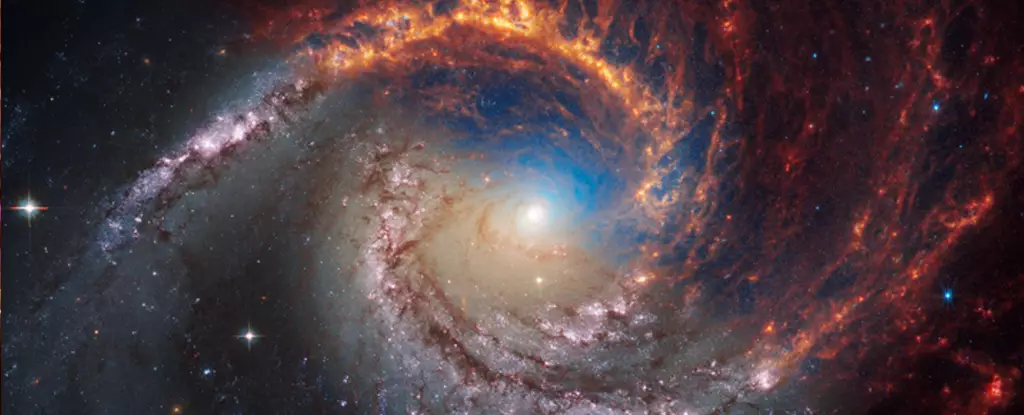The captivating allure of Nature has always mesmerized humanity, and these mesmerizing images of spiral galaxies taken by the James Webb Space Telescope (JWST) only intensify this fascination. Encapsulating remarkable detail, the JWST has captured a series of face-on images of 19 spirals that reveal the intricate splendor of galactic arms adorned with countless stars. These breathtaking images, illuminated in infrared light, also unveil the enigmatic cores of these spirals, where supermassive black holes reside. Imaged as part of the Physics at High Angular resolution in Nearby GalaxieS (PHANGS) program, these images contribute to our understanding of the intricate interplay between gas, star formation, and galactic structure in the universe’s tapestry.
One of the primary scientific objectives of the JWST is to unravel the enigma surrounding the formation and evolution of galaxies. The PHANGS program plays a significant role in fulfilling this mission, drawing on the contributions of not only the JWST but also the VLT, ALMA, and the renowned Hubble Space Telescope. By harnessing the power of both near-infrared (NIR) and mid-infrared (MIR) light, the JWST delves into the unseen depths of the cosmos, exposing a wealth of previously concealed details. Its superiority over the Hubble Space Telescope, which operates predominantly in visible light, ultraviolet light, and a fraction of infrared light, allows the JWST to reveal new facets of these celestial marvels.
These high-resolution images acquired by the JWST exhibit a unique interplay of colors, each with its own cosmic tale to tell. The resplendent red hues emanate from gas and dust, illuminated by the radiant glory of infrared light—an area in which the JWST excels. Notably, some images exhibit bright diffraction spikes in the heart of the galaxies, indicative of an intense influx of light. This may signify the presence of an active supermassive black hole or a dense concentration of luminous stars. Eva Schinnerer, a staff scientist at the Max Planck Institute for Astronomy in Heidelberg, Germany, echoes this sentiment, stating, “That’s a clear sign that there may be an active supermassive black hole. Or, the star clusters toward the center are so bright that they have saturated that area of the image.”
The spatial distribution of stars within a galaxy often reveals a riveting saga of stellar generation. It is a well-established cosmic principle that stars closer to a galaxy’s center tend to be significantly older compared to their counterparts in the celestial arms. These younger stars, resplendent in their hues of blue, have shed their gaseous and dusty cocoons, venturing forth into the cosmic expanse. In contrast, the warm orange clumps signify stars in the nascent stages of their existence. These infant stars remain enshrouded in their blankets of gas and dust, actively accumulating matter and perpetuating the celestial dance of creation. Erik Rosolowsky, a professor of physics at the University of Alberta in Edmonton, Canada, highlights the significance of these regions: “These are where we can find the newest, most massive stars in the galaxies.”
The unveiling of these captivating images is accompanied by a visual narrative from the famed Hubble Space Telescope. By observing galaxies across various wavelengths, including visible light, infrared light, ultraviolet light, and radio waves, astronomers gain unprecedented insights into the vast cosmic expanse. Since the human eye cannot discern infrared light, different visible colors are assigned to respective wavelengths, aiding in meaningful interpretation. In comparing the JWST image of NGC 628 with the Hubble image, it becomes apparent that different color assignments highlight distinct cosmic features. The JWST’s blue depiction emphasizes the galaxy’s center, populated by aged stars emitting the shortest wavelengths of detectable light. In contrast, the Hubble image assumes a more muted yellow tone, reflecting the longer wavelengths of light it perceives.
Since commencing its scientific operations, the JWST has bestowed astronomers with an overwhelming influx of data, destined to fuel the pursuit of knowledge for years to come. These stunning images represent only a fraction of this data release, which also includes a catalog of approximately 100,000 star clusters. Erik Rosolowsky of the University of Alberta expresses the immense potential within these images, stating, “The amount of analysis that can be done with these images is vastly larger than anything our team could possibly handle.”
The unveiling of these mesmerizing spiral galaxies through the lens of the JWST provides a breathtaking glimpse into the secrets of galactic structure and evolution. These captivating images open windows into the cosmic expanse, revealing the interplay between gas, star formation, and the complex dance of stellar generations. As discoveries deepen and data pours forth from the depths of space, humanity’s quest to comprehend the mysteries of the universe continues unabated.


Leave a Reply